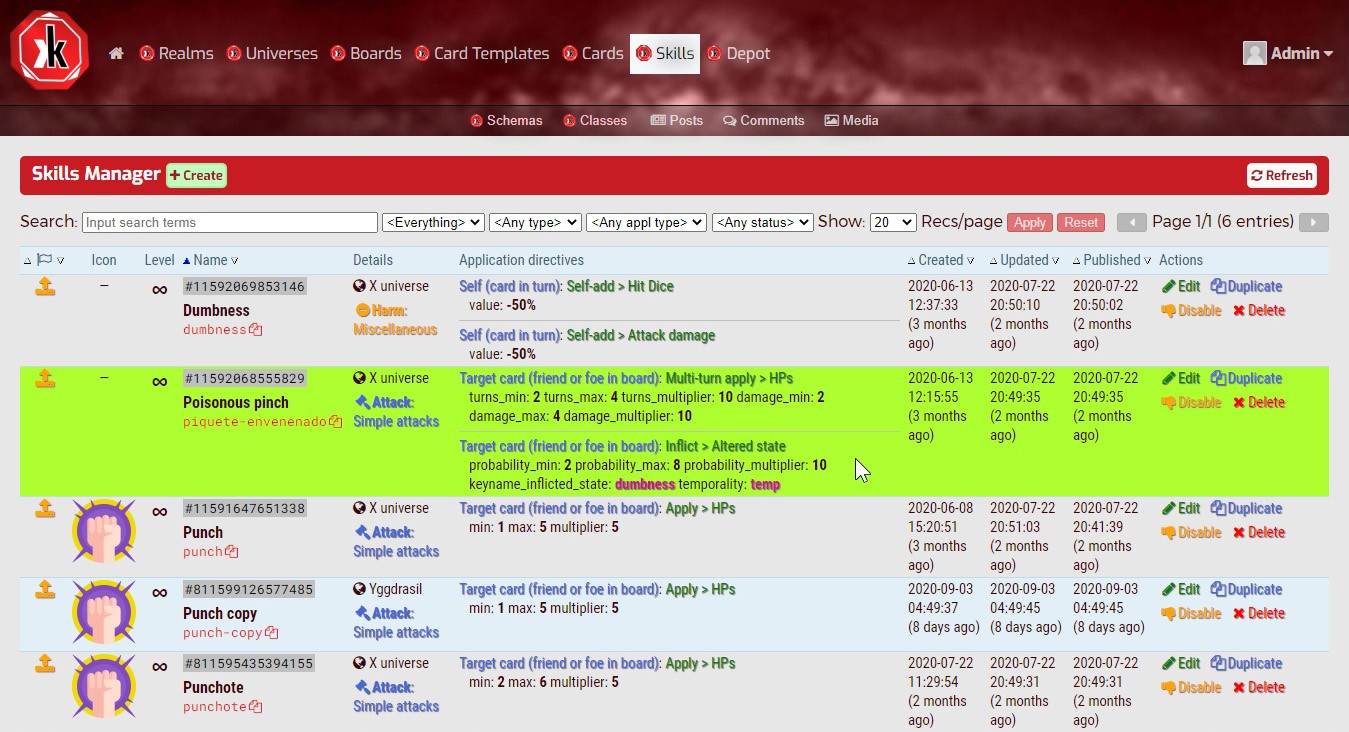Kobol has a complex attributes system that was designed to give players a rich gaming experience, and the proper way to handle such system in a match is through skills.

The skills manager
Basic settings
- Skills are universe oriented and they can be shared among all creatures of the same universe. This has been done to ease the creation of large amounts of characters in a universe: when skills are shared, a lot of time can be saved.
- They can be categorized using the structures in the classes tree. This also helps organizing them.
- They might have a base element.
- They can have level limits to allow the card using them only when gaining certain level or until they reach a certain level.
Skill types and application types
There are three types of skills:
- Attack: the skill attributes will cause damage to the target cards.
- Harm: the skill attributes are used to alter defenses or inflict altered states.
- Support: the skill attributes will be used to benefit friends or foes on the board.
And there are application types:
- Immediate: the skill si casted immediately after placing the card.
- Passive: the card will use the skill when necessary, E.G. dodging an attack or self-healing.
- Preemptive: casted immediately after placing the card on the board, before starting the attack round.
- Final: casted after the attack round.
Normally, skills are activated automatically unless user input is mandatory. When a user places a card on a board, the next procedure is executed:
- If the card has any preemptive skills (E.G. boosting spells), they are all executed.
- Selection of the most useful attack (if the card has more than one available) and its execution.
- If the card has any final skills (E.G. auto-resurrect, final blow, etc.) they are all executed.
Passive skills will be constantly checked for application before and after the steps of the procedure and when the card receives an attack.
Application directives
A good example of how to define the skill actions can be an immediate attack from a poisonous creature. The application directives for this attack could be the next:

Directives are interpreted from top to bottom:
-
Target card: Multi-turn apply > HPs:
The skill does a damage of 2 to 4 HPs (damage_min,damage_max) for every 10 levels of the caster (damage_multiplier) that will remain for 2 to 4 turns (turns_min,turns_max) plus 1 turn for every 10 levels of the caster. -
Target card: Inflict > Altered state: Once the damage is applied by the attack, a probability check between 2% and 8% (
probability_min,probability_max) that will double every 10 levels of the caster (probability_multiplier) will take place (E.G. 4% every 10 levels). If the check is possitive, "dumbness" (keyname_inflicted_state) will be temporarily applied (temporality), that is, during the match.
The altered state being inflicted ("dumbness") is a separate skill defined as immediate attack, and is invoked by the in-match altered states executive process to apply the next directives over the affected card:

-
Self: Self-add > Hit Dice
The maximum card life is reduced to half. -
Self: Self-add > Attack damage
The maximum card damage is reduced to half.
Simplicity is a winner
The application directives example above is a case with certain level of complexity, and not much skills might need to have the same or even a higher complexity level.
It is highly recommended to keep skills as simple as possible and make the complex ones only for special types of cards.

